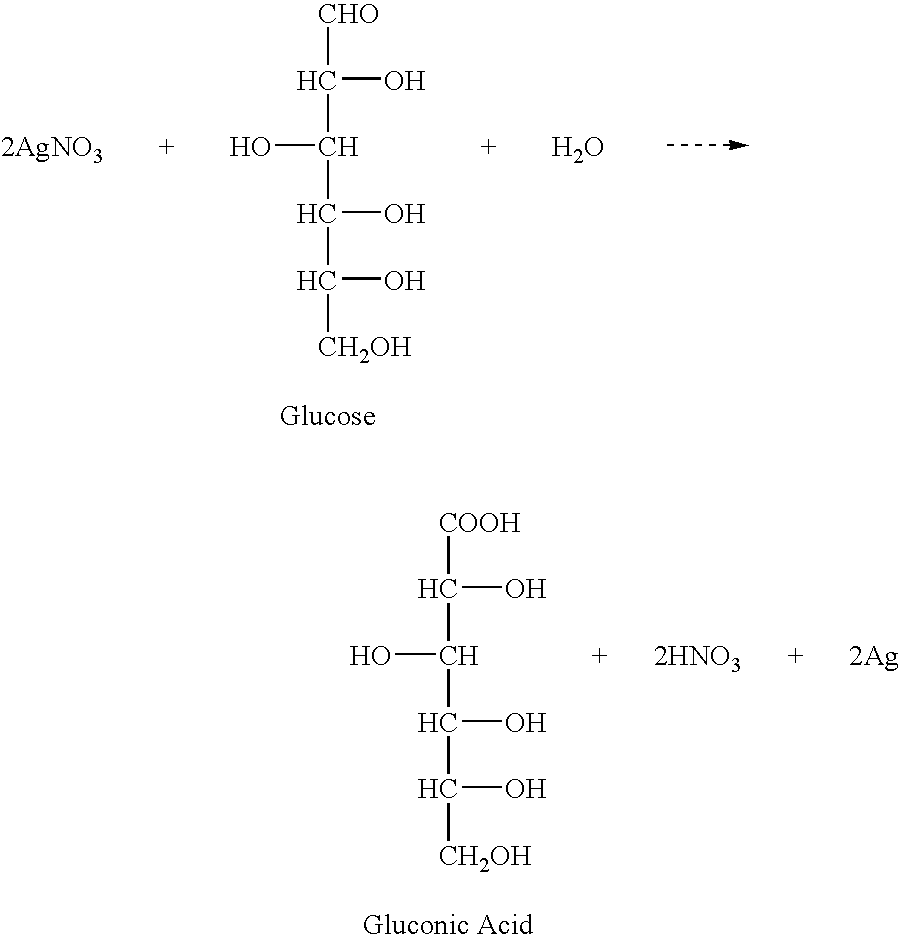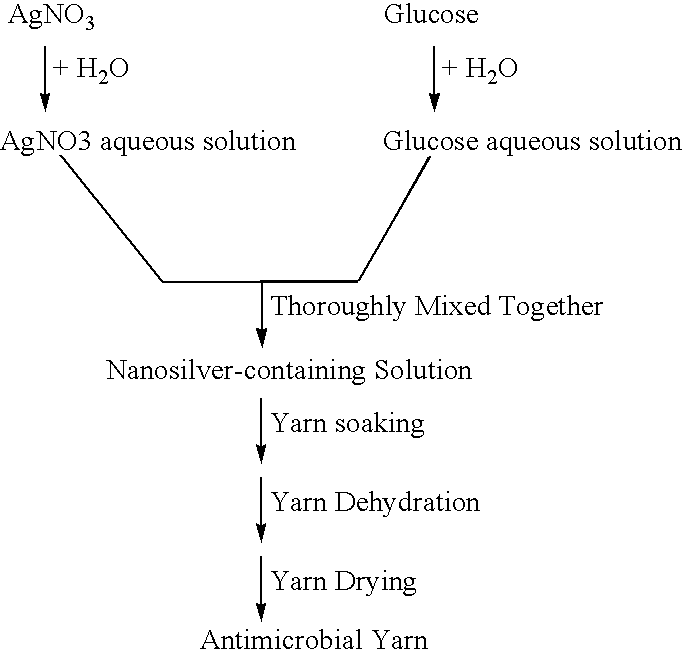Antimicrobial yarn having nanosilver particles and methods for manufacturing the same
a technology of nanosilver particles and nanosilver yarn, which is applied in the direction of in-vivo radioactive preparations, conductive materials, chemical vapor deposition coatings, etc., and can solve the problems of inability to acquire metal resistance of bacteria treated by these metals, serious problems, and high cost of products
- Summary
- Abstract
- Description
- Claims
- Application Information
AI Technical Summary
Benefits of technology
Problems solved by technology
Method used
Image
Examples
example 2
Preparation of Industrial Scale of Antimicrobial Yarn
[0059] (1) Preparation of Nanosilver Particles-Containing Solution
[0060] (a) Silver Nitrate Solution:
[0061] AgNO.sub.3 5.5 kg
[0062] Dissolved in 200 L of Water
[0063] The silver nitrate aqueous solution was prepared by dissolving 5.5 kg of silver nitrate in 200 L of water at room temperature in a 500-litre reaction container.
[0064] (b) Reducing Solution:
[0065] Glucose 5.7 kg
[0066] Dissolved in 150 L of Water
[0067] The aqueous solution of Glucose was prepared by dissolving 5.7 kg of glucose at room temperature in 150 L water in a 200-litre reaction container to form an aqueous solution of glucose.
[0068] (c) Nanosilver Particles-Containing Solution:
[0069] The nanosilver particle-containing solution was prepared by mixing the silver nitrate solution with the reducing agent solution. Additional water was added to the mixture to make the volume up to 500 L. The mixture was stirred thoroughly at room temperature (25.degree. C.) until a t...
example 3
Electron Microscopic Studies of the Antimicrobial Yarn
[0076] (1) Purpose:
[0077] The yarn produced by the method described in Example 1 was analyzed for the dimension and distribution of nanosilver particles attached.
[0078] (2) Method:
[0079] Five samples of the antimicrobial yarn prepared in Example 1 (supra) was examined according to the procedure described in the JY / T011-1996 transmission electron microscope manual. JEM-100CXII transmission electron microscope was used with accelerating voltage at 80 KV and resolution at 0.34 nm.
[0080] (3) Results:
[0081] As shown in FIG. 1, all six batches of the antimicrobial yarn samples contained nanosilver particles which were evenly distributed to the yarn. Batch No. 010110 (FIG. 1A) contained about 62% of nanosilver particles that were under 10 nm in size, about 36% that were about 10 nm in size, and about 2% that were 15 nm in size. Batch No. 001226 (FIG. 1B) contained about 46% of nanosilver particles that were under 10 nm in size, about 47...
example 4
Broad Spectrum of Antimicrobial Activity of the Yarn
[0084] (1) Purpose:
[0085] The antimicrobial yarn prepared in Example 1 was examined to determine the antimicrobial activity of the yarn.
[0086] (2) Method:
[0087] Both the antimicrobial yarn of the present invention (the experimental group) and the yarn without the attachment of nanosilver particles (the control group) were tested in the test tubes.
[0088] Microbial strains tested were Escherichia coli, Methicillin resistant Staphylococcus aureus, Chlamydia trachomatis, Providencia stuartii, Vibrio vulnificus, Pneumobacillus, Nitrate-negative bacillus, Staphylococcus aureus, Candida albicans, Bacillus cloacae, Bacillus allantoides, Morgan's bacillus (Salmonella morgani), Pseudomonas maltophila, Pseudomonas aeruginosa, Neisseria gonorrhoeae, Bacillus subtilis, Bacillus foecalis alkaligenes, Streptococcus hemolyticus B, Citrobacter, and Salmonella paratyphi C. These strains were either isolated from clinical cases or purchased as standa...
PUM
| Property | Measurement | Unit |
|---|---|---|
| Fraction | aaaaa | aaaaa |
| Percent by mass | aaaaa | aaaaa |
| Angle | aaaaa | aaaaa |
Abstract
Description
Claims
Application Information
 Login to View More
Login to View More - R&D
- Intellectual Property
- Life Sciences
- Materials
- Tech Scout
- Unparalleled Data Quality
- Higher Quality Content
- 60% Fewer Hallucinations
Browse by: Latest US Patents, China's latest patents, Technical Efficacy Thesaurus, Application Domain, Technology Topic, Popular Technical Reports.
© 2025 PatSnap. All rights reserved.Legal|Privacy policy|Modern Slavery Act Transparency Statement|Sitemap|About US| Contact US: help@patsnap.com



